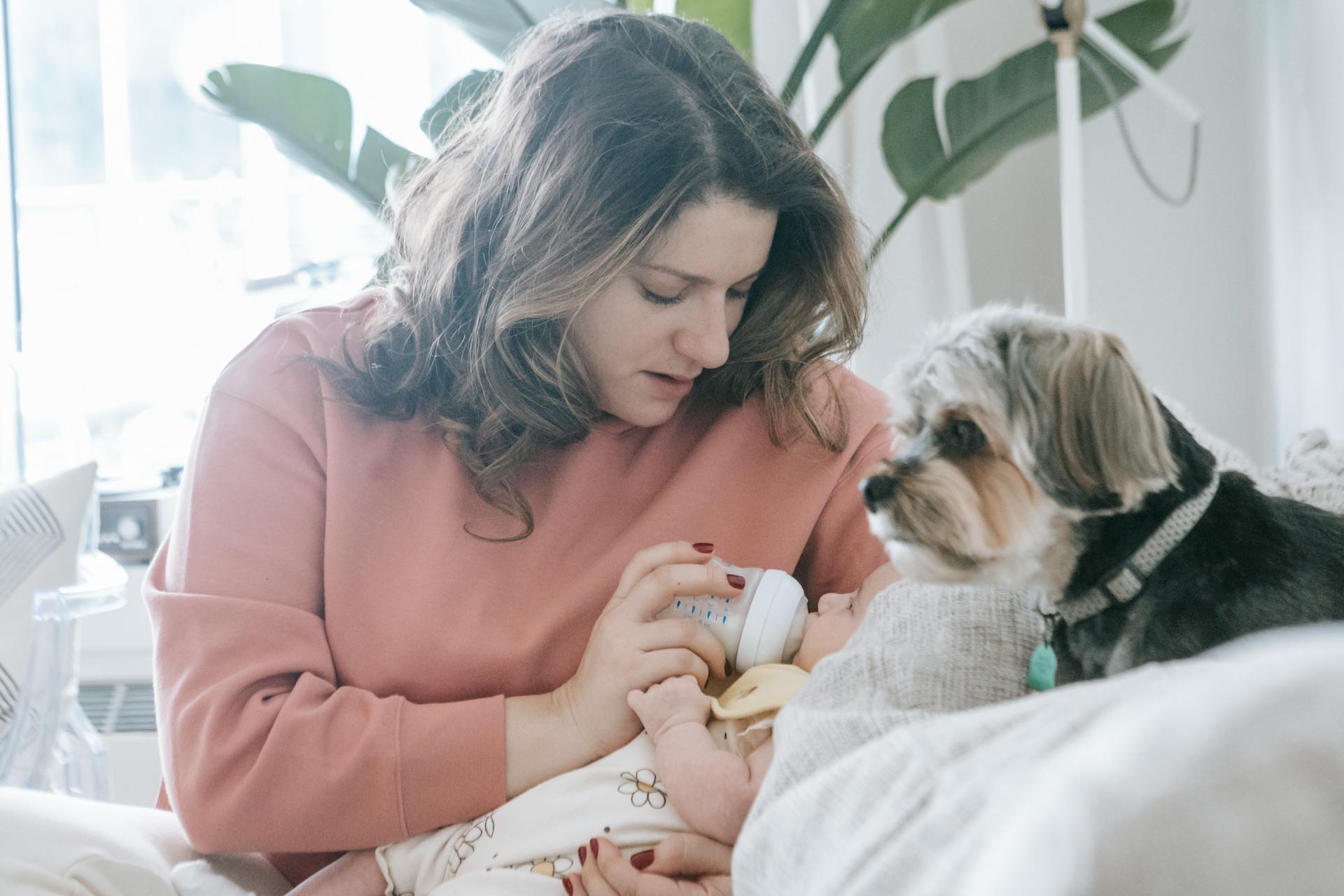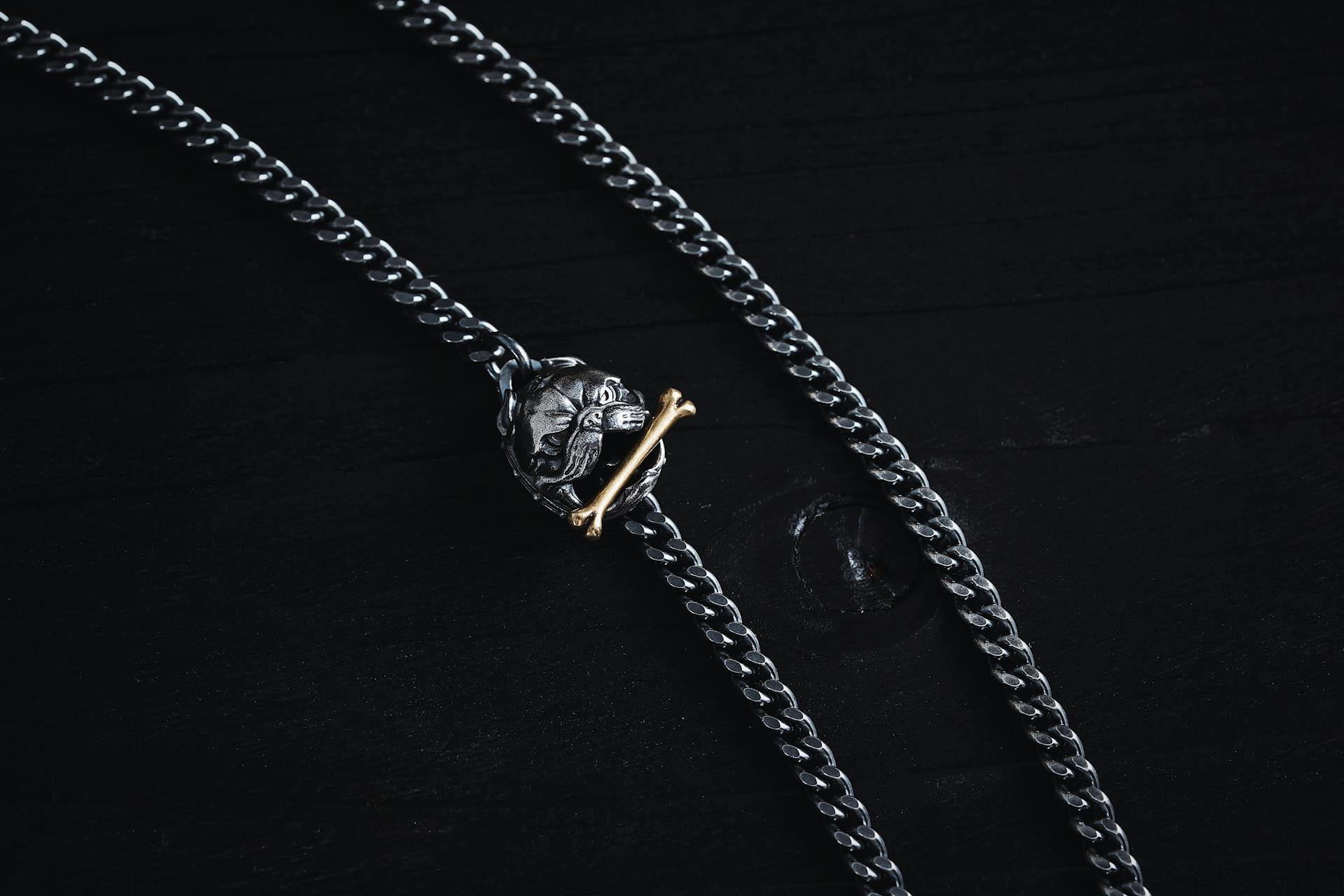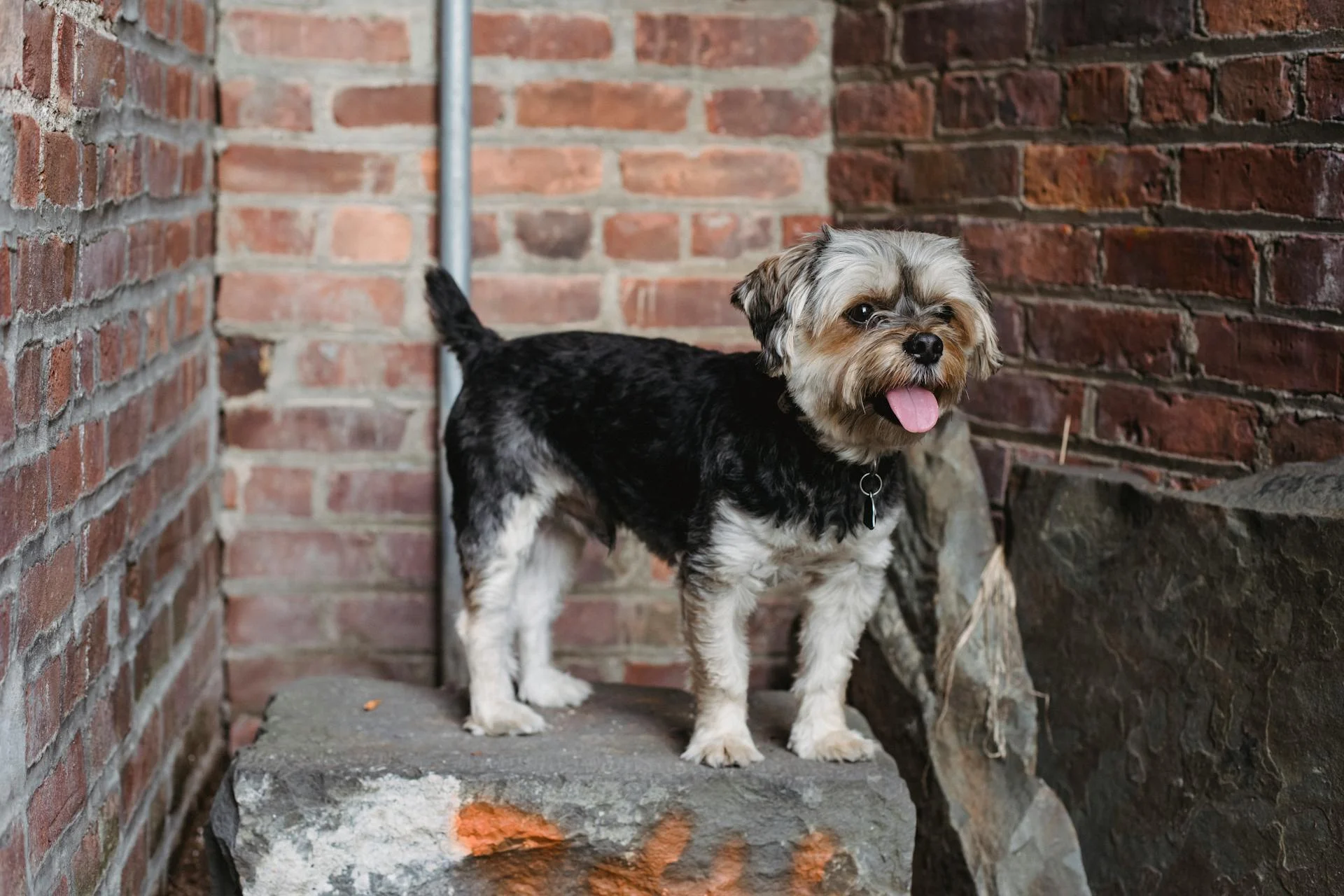
The Havanese Poodle mix, also known as a Hapoo, is a crossbreed between a Havanese dog and a Poodle. This unique combination creates a friendly and outgoing companion.
They generally weigh between 7-13 pounds and stand 8-11 inches tall at the shoulder. Havanese Poodle mixes are known for their low-shedding coat, making them a great choice for those with allergies.
Their intelligence and trainability make them a popular choice for families and first-time dog owners. With proper training and socialization, they can thrive in a variety of living situations.
Their lifespan is typically 12-15 years, with some living up to 18 years or more with proper care and attention. Regular grooming is essential to prevent matting and tangling of their fur.
Appearance
The Havapoo's appearance can vary widely, even within the same litter, due to the combination of Havanese and Poodle traits.
Havapoos can range in size from 10 to 45 pounds, with many adult dogs staying under 20 pounds. This is because the Poodle parent can be a toy, miniature, or standard Poodle.
Their round, dark brown eyes are a universal trait among Havapoos, and they often have floppy ears and a cute-as-a-button black nose.
Their fluffy tails are a distinctive feature, and many Havapoos have a soft, shiny coat that's wavy or curly, similar to a Poodle's.
The Havapoo's coat comes in a wide range of colors, including white, black, brown, apricot, silver, blue, chocolate, and many others.
Havapoos are known for being low shedders, thanks to their Poodle roots, making them a good choice for people with pet allergies.
Temperament
The Havapoo temperament is a true delight. They're loving, affectionate companions who thrive on attention and interaction.
Havapoos are generally easy-going and intelligent, making them a breeze to train. With positive reinforcement, they'll learn tricks in no time and be eager to show them off.
They're not typically a yappy dog, but they can be quick to bark when someone new approaches. However, they're just as likely to run up and greet the newcomer with happy licks and lots of bouncing.
This playful breed demands daily exercise and stimulation to be happy and healthy. They need plenty of walks, playtime, and mental stimulation to keep them engaged.
Havapoos are great with other family pets, including cats and other dogs, but they do require early socialization and training to ensure they understand when it's okay to bark and when it's not.
As a Havapoo owner, you can expect a loyal and friendly companion who'll be by your side at all times. They're prone to separation anxiety, so be prepared to spend quality time with them when you're home.
With their high intelligence, Havapoos are easily trainable, but they can become mischievous if they don't receive enough attention and stimulation. Be prepared to provide plenty of toys, playtime, and affection to keep them happy and healthy.
Living Needs
Living in an apartment with a Havapoo is definitely doable. They're adaptable and can thrive in small spaces as long as their exercise needs are met.
Havapoos require regular exercise to stay happy and healthy. They need daily walks and playtime to keep them entertained and prevent boredom.
They can also be easily trained to be quiet and not bark excessively, making them a great choice for apartment living.
Do Shed?
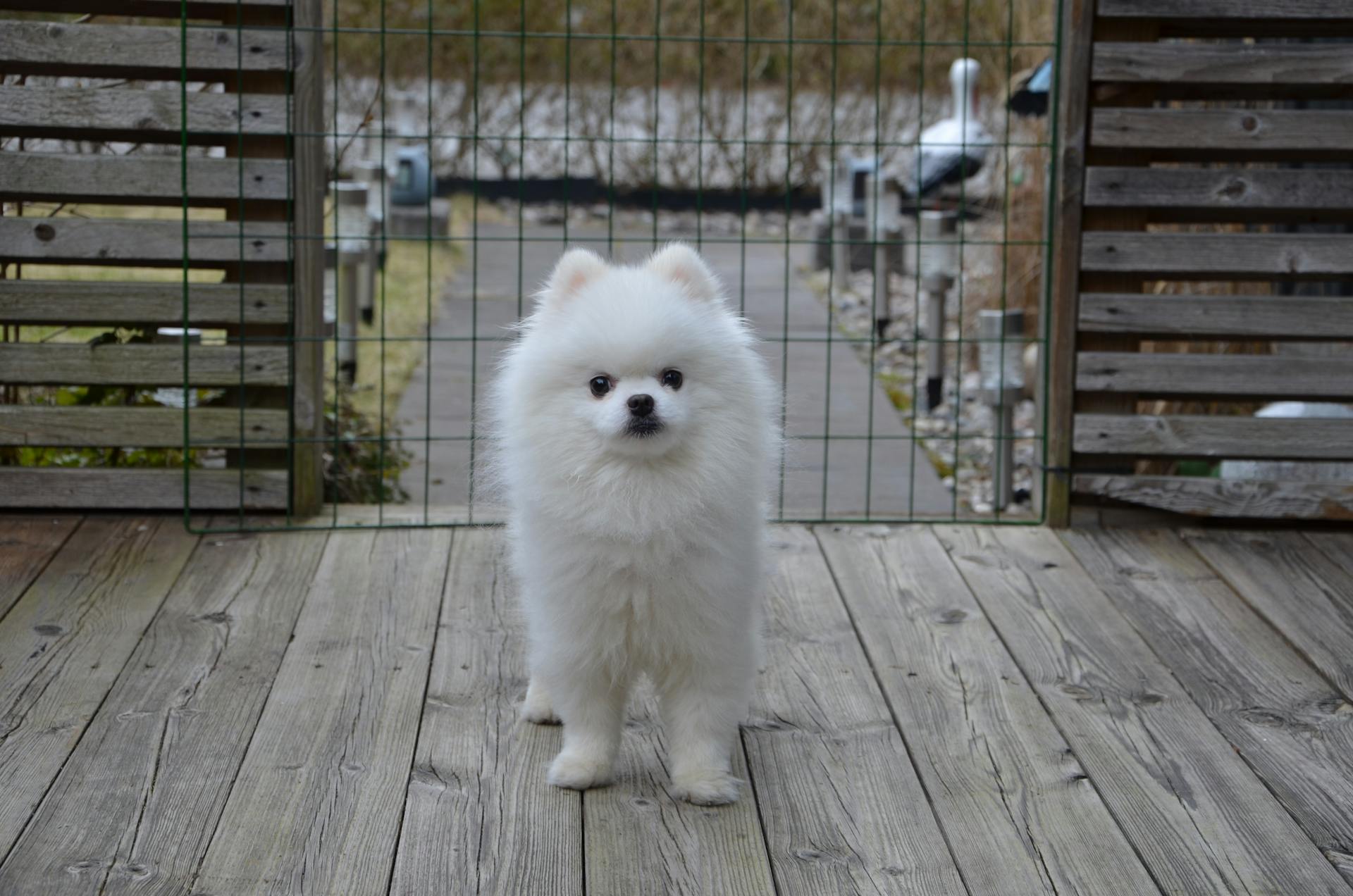
The Havapoo's shedding habits are a concern for many potential owners. They rarely shed.
Regular grooming is a must for Havapoos, with brushing required at least two or three times a week to keep their coats in top shape.
A monthly bath is also beneficial for Havapoos, helping to keep their coats clean and healthy.
Their low shedding frequency makes them a suitable option for people with allergies, but it's essential to remember that no dog is 100% hypoallergenic.
Expand your knowledge: Havanese Puppies Shed
Are Apartment?
Living in an apartment can be a great option for many dog owners, but it's essential to consider the needs of your furry friend. Havapoos, for instance, are adaptable and can happily live in apartments as long as their exercise needs are met.
Their exercise needs can be met with regular walks and playtime, making them a great choice for apartment dwellers who may not have a large yard. They are also relatively quiet, and can be easily trained not to bark excessively, meaning they won't disturb other neighbors in the apartment block.
Care
Grooming is a must for Havapoo owners, and it's not just about looking good - it's also about feeling good. A dedicated owner can handle most grooming needs with regular brushing, but a professional groomer may be necessary to keep their coat looking its best.
Their fur can lead to ear infections if not properly maintained, so regular ear cleaning is a must. Some experts recommend plucking the hair in the ear canals to prevent infections, but it's best to discuss this with your veterinarian as every dog is different.
To prevent issues like trichiasis and excessive tearing, keep their facial hair groomed short. And don't forget about the "fecal bun" - a painful and problematic issue that can occur if their rear end isn't kept well groomed. Regular nail trims are also essential to prevent clicking on the floor.
On a similar theme: Best Dog Breed Crosses
How to Care for a Pet
To keep your Havapoo's ears healthy, regular ear cleaning is a must. You can use ear cleaning solution to keep those ears clear, but be sure to discuss your options with your veterinarian.
Brushing your Havapoo a few times a week is essential to prevent tangles and mats. Pay special attention to areas like the eyes, ears, and rear end.
Frequent grooming can help prevent ear infections caused by extra hair in the ear canals. Some experts recommend plucking this hair regularly, but it's best to discuss this with your veterinarian.
To prevent facial hair from rubbing on the eye, keep the hair on the face groomed shorter. This will help prevent issues like trichiasis and excessive tearing.
Regular nail trims are also a must to prevent clicking and scratching sounds on the floor. It's a simple task that can make a big difference in your Havapoo's comfort and health.
To keep your Havapoo's bottom clean, regular grooming is a must. If you notice matting or dirt accumulation, consider getting a sanitary shave to prevent skin infections and other issues.
Meeting your Havapoo's physical and mental stimulation needs is crucial for their happiness and well-being. Use consistent reward-based training to keep them engaged and motivated.
Be mindful of your Havapoo's weight, as overfeeding can lead to health issues. Use part of their meals as treats for training, and keep an eye on their weight with their vet.
Twice-yearly vet checkups are a must to catch any potential health problems early on. Regular exercise and a nutritious diet will also help your Havapoo thrive.
Related reading: Havanese Training
Alternative
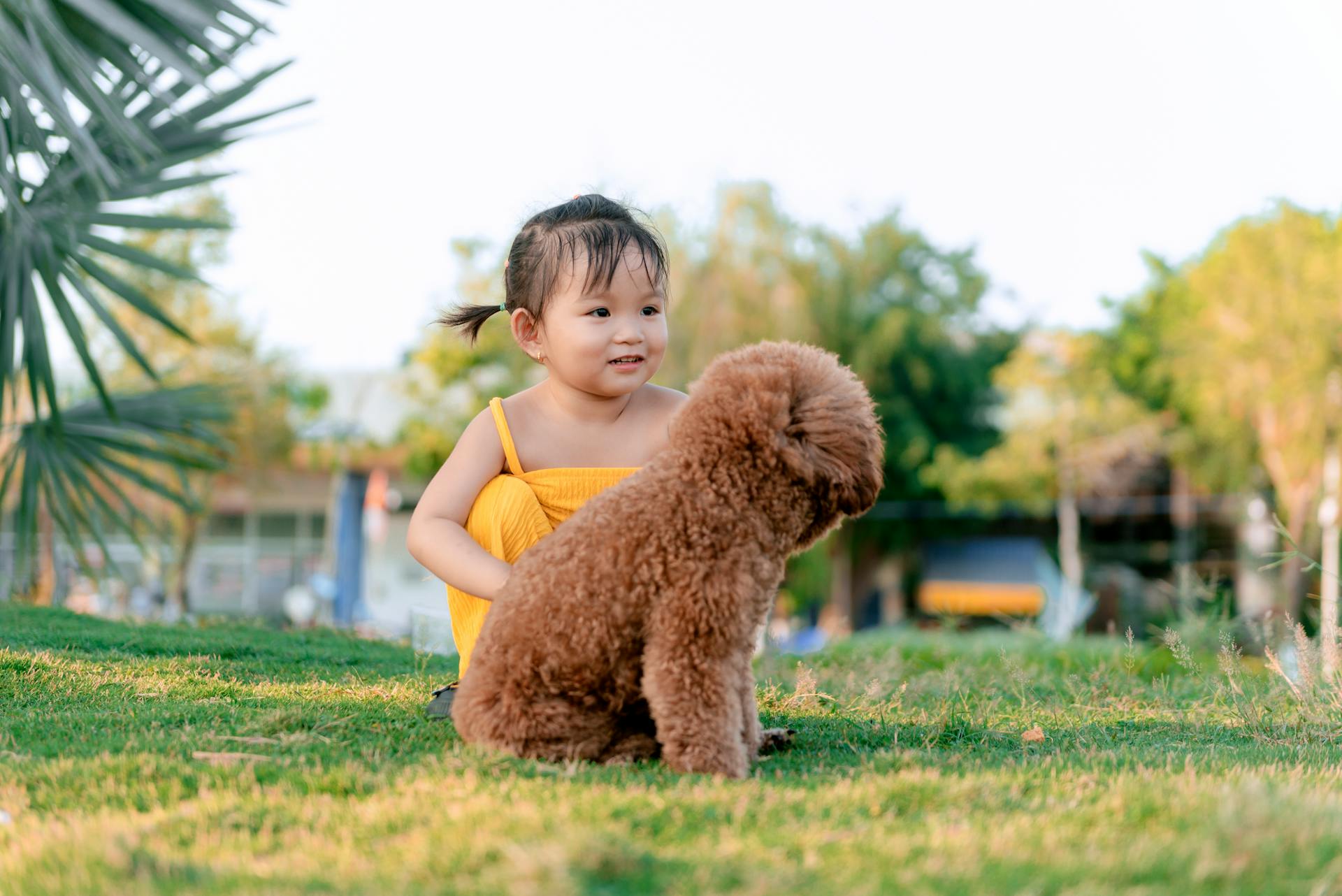
If you're considering a Havapoo but want to explore other options, you might want to look into alternative breeds. Havapoos are prone to health problems such as bloat and cataracts, so it's essential to research breeds with similar characteristics.
Havapoos need frequent exercise and a nutritious diet, so you'll want to choose a breed that requires a similar level of care. They also thrive on attention, so a breed that's equally affectionate and playful would be a great fit.
If you're looking for breeds with similar grooming needs, you might consider the Aussiedoodle, Double Doodle, or Goldendoodle. These breeds have high grooming needs and require regular exercise to stay happy and healthy.
If you're considering a breed that's easy to train, the Labradoodle, Sheepadoodle, or Yorkipoo might be a good choice. They're all highly intelligent and respond well to training.
Here are some alternative breeds to consider:
- Aussiedoodle (Australian Shepherd Poodle Mix)
- Double Doodle (Labradoodle Goldendoodle Mix)
- Goldendoodle (Golden Retriever Poodle Mix)
- Labradoodle (Lab Poodle Mix)
- Sheepadoodle (Old English Sheepdog Poodle Mix)
- Shepadoodle (German Shepherd Poodle Mix)
- Woodle (Welsh Terrier Poodle Mix)
- Yorkipoo (Yorkie Poodle Mix)
Health
The Havapoo is a relatively healthy dog breed, with a lifespan of 10-15 years. They can experience some health issues common to their parent breeds, such as kneecap disorders and dental disease.
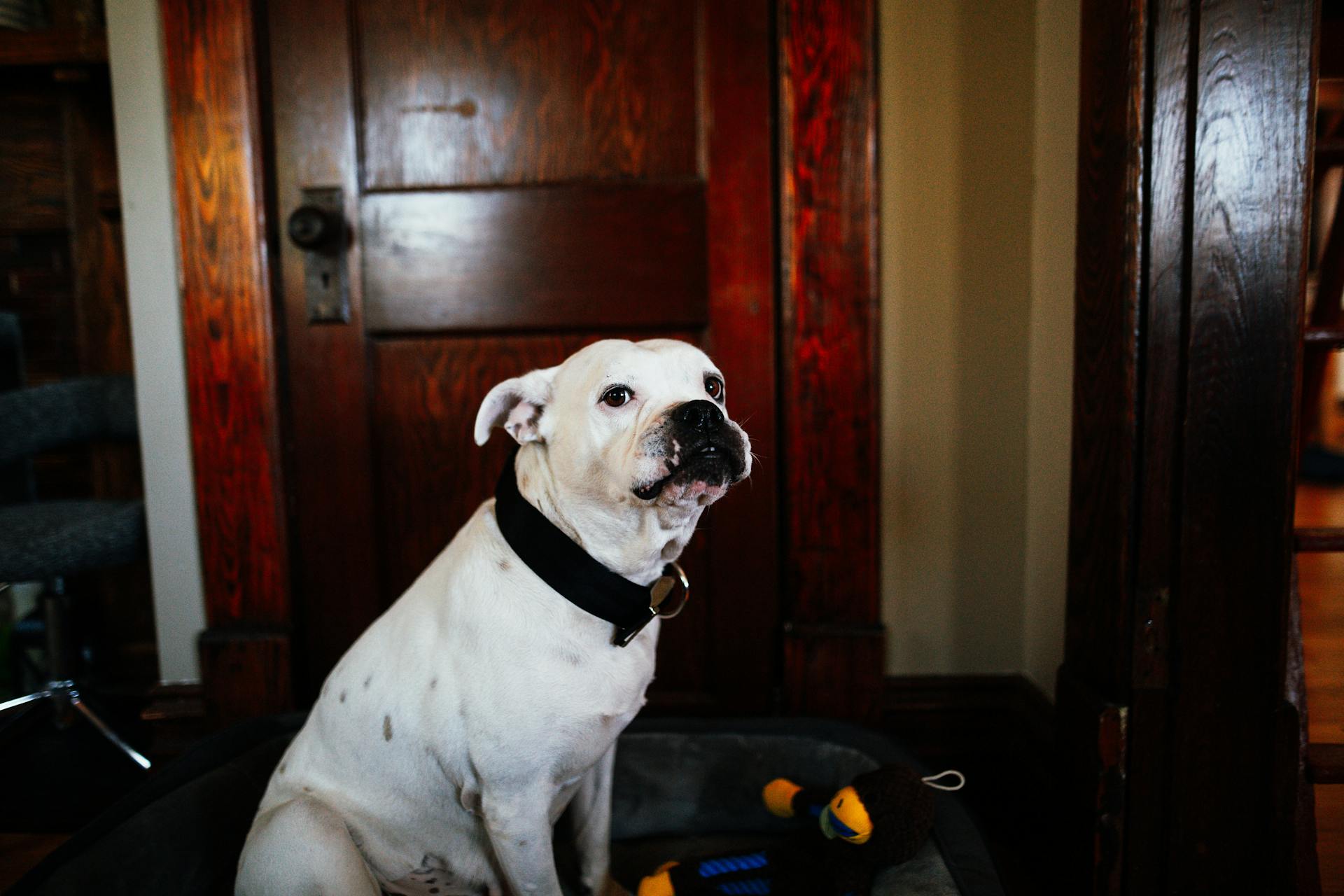
A common sign of kneecap disorders, also known as medial luxating patellas, is limping or holding up a back leg suddenly. Some dogs adapt to this condition, but others require surgery to correct it.
Dental disease is another common issue for small dogs like the Havapoo. Brushing their teeth regularly and having routine dental cleanings with a veterinarian can prevent this issue.
Here are some health issues you may see in the Havapoo breed:
- Eye disorders
- Chondrodysplasia
- Deafness
- Heart murmurs
- Legg-Calve-Perthes disease
- Patellar luxation
Some health issues that can affect Havapoos include bloat, hip dysplasia, cataracts, thyroid issues, and skin conditions. Regular vet checkups, a healthy diet, and frequent exercise can help prevent or manage these issues.
With proper care, most Havapoos can live long, healthy lives, with an average lifespan of 10-18 years.
Check this out: Havanese Skin Issues
Fun Facts
The Havapoo might not be recognized as a purebred dog by the American Kennel Club, but it's recognized by several other clubs, including the American Canine Hybrid Club and the Designer Breed Registry.
The Havapoo isn't the only Havanese hybrid out there - you'll also find the Havachon (a mix of Havanese and Bichon Frise) and the Hava-Apso (a mix of Havanese and Lhasa Apso).
These hybrids can look similar to each other, but they're definitely not the same as the Cavapoo, which is a mix of Cavalier King Charles Spaniel and Poodle.
Here are some of the organizations that recognize the Havapoo as a breed:
- American Canine Hybrid Club
- Designer Dogs Kennel Club
- Dog Registry of America, Inc.
- Designer Breed Registry
History
The Havapoo breed has a relatively new history, emerging in the 1980s as breeders began intentionally mixing Havanese and poodles together.
This movement was part of a larger trend that started in the 1980s and 1990s, where breeders aimed to create new hybrids with decreased shedding and lower allergenic effects.
The Havapoo became a popular mix in the 2000s, when they were originally bred, and is known for having two hypoallergenic parents.
Breeders likely sought to produce a dog with the Havanese's affectionate, playful temperament, but with fewer health issues.
The Havapoo's parent breeds, the Havanese and poodle, are both recognized by the American Kennel Club (AKC), but the Havapoo itself hasn't received official recognition.
Discover more: Havanese vs Cavapoo
Coat Grooming
Havapoos require regular brushing to prevent matting and tangling of their fur, which should be done at least twice a week.
Their coats are prone to matting, especially in the bottom area, so it's essential to keep an eye on this area and trim the hair regularly to prevent a "fecal bun" from forming.
Bathing a Havapoo should be done about every three weeks to once a month, but lighter colored Havapoos may need to be washed more frequently.
You should also pay attention to the area around their eyes, as the hair can get long and rub in their eyes, causing pain and irritation.
Their ears are prone to ear infections, so it's crucial to keep their hair trimmed and their ears clean.
Nail length is also important, and you should expect to trim their nails every 3-4 weeks to keep them healthy and prevent them from unintentionally scratching people.
If this caught your attention, see: Do Havanese Have Hair or Fur
Regular, at least weekly, teeth cleaning is also necessary to prevent dental disease, which can develop by the time a dog is two years old.
Their coats come in a variety of colors, including white, black, brown, apricot, silver, blue, chocolate, white, fawn, gold, gray, and cream, and are usually curly or wavy.
Discover more: Shih Tzu Poodle Mix Black and White
Size and Appearance
Havapoos typically grow up to 18 inches tall and weigh between 7 and 30 pounds, but the exact size can vary depending on the size of the poodle parent.
Their fluffy tail is a distinctive feature, and they often have dark brown eyes, floppy ears, and a cute button nose.
A Havapoo's coat is soft, shiny, and wavy or curly, similar to a poodle's, and comes in a wide range of colors.
They don't shed much, making them a good choice for people with pet allergies.
Havapoos can vary in size and appearance even within the same litter, especially early on when the puppy is still growing.
Most Havapoos stay under 20 pounds, as miniature and toy poodle parents are more common than standard poodle parents.
The size of the poodle parent can affect the size of the Havapoo, with toy poodles resulting in smaller dogs and standard poodles resulting in larger dogs.
Havapoos can range in size from 7 to 45 pounds, depending on the size of the poodle parent.
Their height can range from 8 to 18 inches, and their weight can range from 7 to 30 pounds.
They often have a medium or long coat that is wavy or curly in appearance, and their ears flop over their face.
Havapoos are a small breed and will not be as tiny as their parents, but they can reach between 7 and 25 pounds.
Most Havapoos stand about 9 to 12 inches tall, but some can reach 12 pounds or more.
Their face looks a lot like a teddy bear, with a round head, rounded dark eyes, and a fluffy, floppy tail.
Regardless of their poodle parent size, most Havapoos will inherit some physical traits, including floppy ears, button noses, and fluffy tails.
Hybrid and Parent
The Havanese Poodle Mix is a cross between a Havanese and a Poodle, also known as a Havapoo or Havanese Poodle Mix.
These dogs go by many names, including Havapoo, Havadoodle, Poovanese, and Havanese Poodle Mix.
They're a cross between two hypoallergenic dog breeds to create a companion dog with a curly coat.
The Havanese Poodle Mix is a relatively new breed, thought to have started in the 2000s as designer dog breeds continued to surge in popularity.
To get to know the Havanese Poodle Mix, it's essential to learn about each parent breed, the Havanese and the Poodle.
The Havanese and Poodle are both highly sought-after breeds, and understanding their needs will help you care for your Havanese Poodle Mix.
The Poodle has achieved worldwide acclaim for their hypoallergenic coats, making them perfect for dog lovers with allergies to canines.
The Havanese can be susceptible to separation anxiety, so it's crucial to consider this when deciding if a Havanese Poodle Mix is right for you.
Curious to learn more? Check out: Hypoallergenic Husky Poodle Mix
What to Eat
Havanese Poodle Mixes are prone to overeating, so it's essential to monitor their food intake.
They need a well-balanced diet made from high-quality ingredients, and small dog kibble or fresh/wet food works well.
Aim for 1/2 to 2 cups of kibble per day, split into two meals, depending on size, activity level, and metabolism.
To keep them interested and engaged, add some variety to their diet and consider adding broth or gravy.
Always look for high-quality foods free from fillers and artificial additives, and discuss any feeding concerns with your veterinarian.
These little guys love to eat, so a regular feeding schedule is crucial to prevent overeating and obesity.
A unique perspective: Are Havanese Dogs High Maintenance
Training and Behavior
Havapoos are incredibly intelligent dogs who are always up for activities that put their brain to good use. They're also alert, curious, and sensitive to the emotions of those around them.
House training and basic commands should be no trouble at all for Havapoos, but owners must be clear, confident, and encouraging. They do well with a lot of positive reinforcement, so be prepared to use plenty of treats.
Havapoos are easy to train because of their high intelligence and eagerness to please. They can pick up commands quickly and can even master complex tricks like playing dead.
Positive reinforcement is key when training a Havapoo, so avoid punishment-based training measures. They're incredibly sensitive, and harsh approaches can cause them to lose trust in you and become anxious.
Havapoos are people pleasers and love to learn new things, making them a delight to train. However, they can become stubborn due to their intelligence, so be patient and consistent.
To keep your Havapoo happy and healthy, they need daily exercise and stimulation. This can include agility training, walks, and playtime, as they're agile and love to play.
Socialization is crucial for Havapoos, especially when they're young. This will help them understand when it's okay to bark and when it's time to be quiet.
Havapoos are prone to separation anxiety, so it's essential to crate-train them. This will keep them safe and out of trouble when you need to leave or when they need a quiet place to retreat.
A unique perspective: Havapoo vs Maltipoo
Adopt a Havanese Poodle Mix
Adopting a Havanese Poodle Mix can be a wonderful option for those looking for a furry companion. Adult Havapoos can sometimes be found in rescue shelters, with adoption fees typically in the range of $50 to $250.
You can try speaking to dedicated poodle or Havanese rescue organizations to see if they have any Havapoo mixes under their care. They often have a wealth of knowledge and can help you find the perfect match.
Shelter dogs can be a great choice for someone who doesn't want a puppy, and they'll cost less too. Far too many doggies need loving homes, and an older pup can bring many years of joy to your life.
Local shelters, rescues, and national groups like the Animal Humane Society may have Havanese and Poodle mixes available for adoption.
For your interest: Big Dog Poodle Mixes
Cost Estimate
The cost of a Havanese Poodle Mix can vary, but expect to pay between $1,800 and $3,000 for a puppy from a reputable breeder.
You should be cautious when looking for a Havapoo breeder, as they don't have a breed standard. Always ask to see a puppy with its mother and father, and request registration papers for the parents, as well as proof of health and veterinary checks.
The monthly cost of owning a Havapoo is typically between $60 and $150, which accounts for expenses like kibble, grooming supplies, treats, and waste bags.
Other potential costs include dog food, pet insurance, grooming, vet trips, and much more, which can add up quickly.
Suggestion: Havapoo vs Havanese
Family and Children
Havapoos make fantastic family pets, they're agreeable, affectionate, smart, and love to play. They're happy to sit on your lap but also enjoy a lively game of fetch.
They do well with children, and other pets, though they form attachments often and don't like to be left alone. As long as you can give them a lot of attention, they'll be a happy guy.
Havapoos are great with kids of all ages thanks to their nurturing, patient, and playful nature. However, these pups have fragile bodies and can't tolerate roughhousing.
Young children should be taught to play with them carefully to prevent injuries. Havapoos who inherit more traits from their poodle parent may also be sensitive to loud noises, so children should be discouraged from shouting or yelling while playing.
Generally speaking, the Havapoo are affectionate, gentle, and sociable. They're not aggressive dogs by any stretch of the imagination, but they won't like to be poked or roughoused.
Health and Wellness
The Havapoo is generally a healthy breed, but like all dogs, they can be prone to certain health issues. They have a lifespan of 10-15 years.
One common issue that can affect Havapoos is kneecap disorder, also known as medial luxating patellas. This is a condition where the kneecap slips out of place, causing limping or sudden holding up of a back leg.
Regular dental care is also crucial for Havapoos, as they are prone to dental disease. Brushing their teeth and having routine prophylactic dental cleanings can prevent this issue.
Some common health issues that can affect Havapoos include eye disorders, chondrodysplasia, deafness, heart murmurs, Legg-Calve-Perthes disease, and patellar luxation. These are inherited conditions from their parent breeds.
It's essential to be aware of these potential health issues when bringing a Havapoo puppy home. Regular vet checkups, a healthy diet, and frequent exercise can help prevent or manage these conditions.
Here are some common health issues that can affect Havapoos:
- Eye disorders
- Chondrodysplasia
- Deafness
- Heart murmurs
- Legg-Calve-Perthes disease
- Patellar luxation
- Bloat
- Hip dysplasia
- Cataracts
- Thyroid issues
- Skin conditions
Frequently Asked Questions
How big do Havanese Poodle mixes get?
Havapoos typically grow to 18 inches tall and weigh between 7-30 pounds, with size varying depending on the poodle type used in breeding. Their exact size can vary, making each Havapoo unique.
What are the negatives of Havapoo?
Havapoos may be prone to certain health issues, including patellar luxation, hypothyroidism, deafness, Addison's disease, cataracts, and epilepsy, which can impact their quality of life and require regular veterinary care. It's essential to research and understand these potential health risks before bringing a Havapoo into your family.
What is better, a Havapoo or a Cavapoo?
Both Havapoos and Cavapoos make excellent companion dogs, with friendly and affectionate personalities that make them great family members. Ultimately, the better breed for you depends on your lifestyle and preferences.
Are Havanese poodles good dogs?
Havanese Poodle mixes are friendly, gentle, and intelligent dogs that make great companions for active families, but they do require patient and positive training. With proper care, they can thrive as loving and adaptable pets.
Do Havapoo dogs bark a lot?
Havapoo dogs may exhibit excessive barking if they don't receive enough attention. This behavior can be managed with proper training and attention from their owners.
Featured Images: pexels.com
